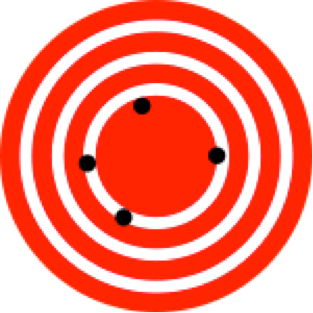Please see the website below for a more complete discussion of accuracy and precision:
https://en.wikipedia.org/wiki/Accuracy_and_precision
Despite the frequent conflation of the terms accuracy and precision in common parlance—we do know the difference. For example, a person displays a “lucky” rabbits foot to their associates. This description may be accurate to the holder of the rabbits foot, however, as someone invariably points out, “It wasn’t too lucky for the rabbit.” In order to precisely describe the rabbits foot one must recognize the rabbit, the person holding it, as well as what they both were and what they have both become (that time, space, identity thing gets complicated really fast). Alternatively, the holder of the rabbit’s foot has already provided an accurate description—and their associate has provided another. Here we will acknowledge accuracy and shoot for precision (pun intended).
These sorts of distortions and impositions, both accurate and precise, form the context of our lives. Charles Dickens certainly recognized the slippery slope on which reality rests when he opened A Tale of Two Cities (written almost 160 years ago) with the memorable, if contradictory, description of a period 240 years ago:
“It was the best of times, it was the worst of times, it was the age of wisdom, it was the age of foolishness, it was the epoch of belief, it was the epoch of incredulity, it was the season of Light, it was the season of Darkness, it was the spring of hope, it was the winter of despair, we had everything before us, we had nothing before us, we were all going direct to Heaven, we were all going direct the other way-- in short, the period was so far like the present period, that some of its noisiest authorities insisted on its being received, for good or for evil, in the superlative degree of comparison only.”
Today, in the course of human events we attempt to achieve accuracy and some degree of precision through a similar “superlative degree of comparison…” evidenced by the explosion in the number of various news outlets (despite the fact that most are actually owned by only a few corporations). Nonetheless, most humans acknowledge that the inclusion of diverse descriptions contributes to both the accuracy and the precision of context. This is certainly true with respect to understanding how people adapt to our ever-changing world.
If time and space frame our material existence (I am unaware, at least experientially, of any other type of existence.) let’s begin our discussion by contextualizing humans in time and space. At the time of this writing (ca. 2016 A.D.) the most current fossil evidence indicates anatomically modern humans are approximately 200,000 years old. Now what we mean by “human” as well as “species” and “sub species” of humans is a hotly debated academic issue at the moment. Genetic research in the last 10 years has identified both Neanderthal and Denisovan (a hominid first discovered about 10 years ago that lived in Central Asia) DNA in humans indicating that mating occurred between 50,000 and 100,000 years ago at a time when humans had emerged from the African continent and likely met Neanderthals and Denisovans somewhere in west and/or central Asia. This also raises the issue that while we consider Neanderthals and Denisovan hominids extinct, many humans alive today carry their DNA—suggesting they are, in fact, very much alive.
At first blush 200,000 years sounds like a long time (people are often surprised to hear that they’ve been around that long). In all fairness when we consider the age of recorded history or writing (barely 6,000 years old), Christianity (2,000 years old), or even the United States (240 years old) the age of humans seems quit long. But when we compare humans to other forms of life on this planet we can begin to see the relative youth of our species. For example, the age of dinosaurs (the Mesozoic Era represented by the Triassic, Jurassic, and Cretaceous periods) began 250 million years ago, and ended 65 million years ago. Comparing people with dinosaurs is, admittedly—apples to oranges. After all, some had enormous bodies and brains the size of walnuts (I’m referring to dinosaurs, of course). But birds too have been around a very long time--at least 130 million years (Wang et al. 2015) and despite the derogatory term “bird-brain”, the intelligence of some (particularly those in the families Corvidae [e.g. ravens, crows, jays, etc.] and Psittacidae [e.g. parrots, macaws, parakeets, etc.]) may be on par with the humans and, like humans, birds managed to expand their range across the entire globe.
As an aside, the evolution of birds from dinosaurs into small, feathered, flying creatures represents a particularly elegant and successful adaptation. In many ways birds have evolved to fill a multitude of ecological niches simply by drastically decreasing body size and increasing thermal insulation and mobility. Imagine if humans were able to reduce their size by 75-80% and could fly—we’d have virtually unlimited resources and access to everything!
Any way you slice it the existence of dinosaurs and birds for over 100 million years is an impressive run, particularly in comparison with humans. Furthermore, while humans pride themselves on their big brains, what we actually know of ourselves is based almost entirely on the historical or documentary (written) record representing approximately the last 6000 years. Although the evidence for proto-writing (ideographic symbols and/or mnemonic devices) and numbers or some form of tallying or accounting extends back several more thousands of years, perhaps well into the Pleistocene (the last ice age), true writing systems in which the content of spoken words could be recorded and reconstructed verbatim seems to be a relatively new innovation. So our knowledge of people prior to writing (prehistory) is limited entirely to the archaeological (material) record, ethnographic analogy, and the earliest historical documents. Although these types of investigations provide insight into the human experience, our knowledge of prehistory is often confined to where, when, and how people obtained food and shelter.
It’s been said that to answer the really fundamental questions of science we must ask big questions such as, “What do we not know?” Our written record constitutes less than 5% of our entire existence—so what we do not know would fill volumes as well as libraries. Yet many of our greatest achievements—art, fire, encountering other hominids and inevitably becoming part of them, migrating and adapting to countless places around the world, the very essence of who we are—including our most profound emotional, mental, and spiritual concepts and how and why we make the decisions we make from moment to moment, day to day, week to week, month to month, and year to year across generations were almost certainly developed tens of thousands of years prior to recorded history. Even a cursory examination of the earliest literature (e.g. The Epic of Gilgamesh, Shijing, Puranas, etc.) shows that most, if not all, of the primary themes found in contemporary literature were already well developed 3000-4000 years ago. These themes (love, beauty, courage, loyalty, temptation, betrayal, cowardice, despair, hate, etc.) may seem intangible, ethereal, but have proven to be quite durable persisting through time and space. Perhaps they, along with our carefully developed but artificial fields of identity, are the only real constants in “interesting times”.
About those “interesting times”… it turns out that this expression was derived from a collection of Chinese short stories published in 1697. The original piece was something to the effect of ‘…better to be a dog in peace than a human in war…’ But British diplomatic officials working in China in the early nineteenth century appropriated the adage, brought it home, changed it, and disseminated it to the world as the Chinese blessing/curse we have come to know today. In fact, Sir Austen Chamberlain used this expression in a 1936 speech to describe events in Europe prior to World War II. It is precisely these types of intended and/or unintended manipulations and impositions that influence how people respond to various situations—in short, how they adapt. All of this is to say that people change and make stuff up as they go along and that is why Dickens noted that in order to understand for themselves what was going the “noisiest authorities” of current events insisted on receiving all the news in a “superlative degree of comparison”. Emphasizing our tenuous grasp of reality, combined with our bias, misrepresentation, and a general predilection for larceny may seem counterintuitive to a discussion of successful human adaptation, but it is important to know who we are dealing with and, after all, we’re only human…

